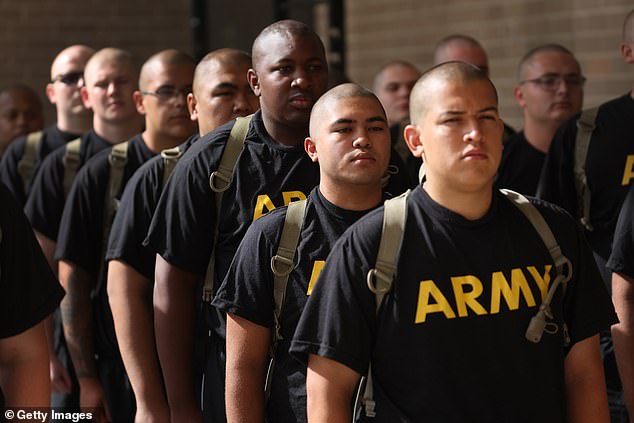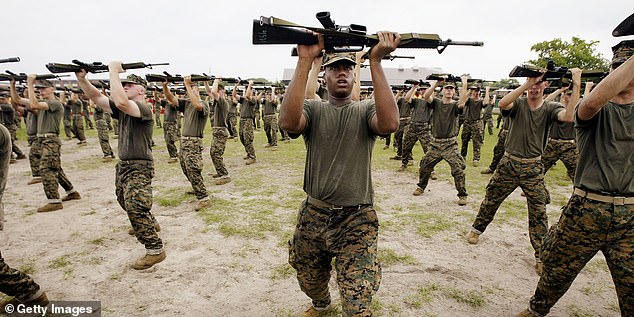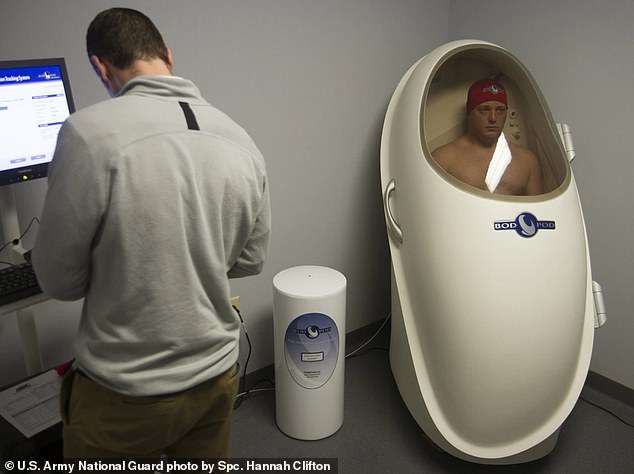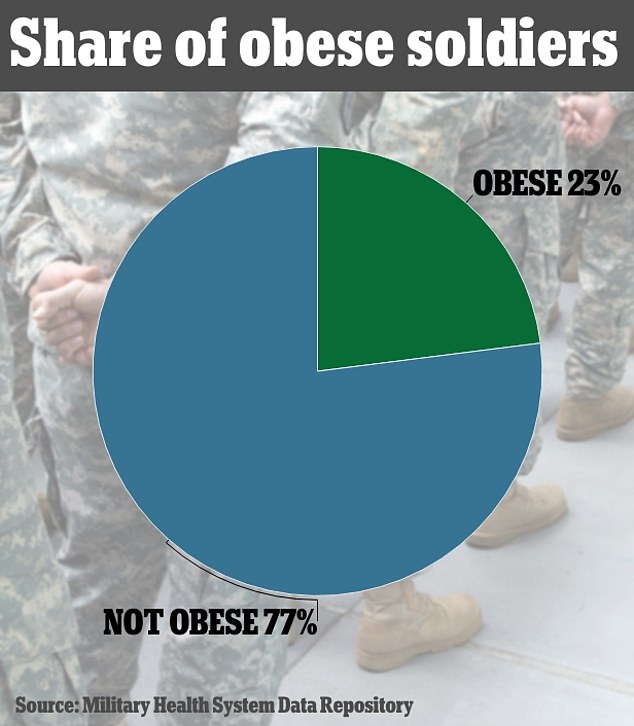America’s military’s fitness crisis: Alarm over rising obesity and number of ‘skinny fat’ recruits who can’t pass physical tests
The US military is battling a fitness crisis caused by a growing number of obese troops and ‘skinny’ recruits who can’t pass fitness tests.
Obesity rates among service members have risen during COVID, and recruiters are also faced with a growing number of prospective soldiers who are simply too big, too weak, or both.
Top buyers are now redefining fitness tests – including the military’s infamous ‘band test’ – and introducing the latest scanning machines that calculate body fat. Troops who fail are put on special programs to get them in shape.
The military’s fitness crisis, viewed by generals as a threat to national security, is compounded by growing obesity rates among all Americans. A recent report by the Center for Disease Control titled ‘Unfit to Serve’ found a staggering one-third of young adults are ‘too heavy’ to serve in the military.
About 23 percent of Army soldiers were obese in 2021, according to a recent study of data from the Military Health System Data Repository. This is compared to 18 percent before the pandemic, which meant that physical work and training were scaled back due to lockdowns.

The US military is battling a fitness crisis caused by a growing number of obese troops and ‘skinny’ recruits who can’t pass fitness tests. Pictured: US Army cadets participating in the Army’s new Future Soldier Prep Course at Fort Jackson, SC on September 28, 2022

Military leaders warn a decline in the fitness of US military personnel poses a threat to national security (file photo)
Study author Tracey Perez Koehlmoos, director of the Center for Health Services Research at the Uniformed Services University in Bethesda, Maryland, said: ‘The military and the other services need to focus on how to get the forces back to fitness.’
Marine Corps Brigadier General Stephen Cheney went further, saying the military’s fitness crisis is a “dramatic national security problem” that is getting “worse and worse and worse.”
Similar declines in fitness were also observed in the Navy and the Marines.
The emerging ‘skinny fat’ phenomenon was highlighted by Dr Karl E. Friedl, a physician and former army officer who led fitness research within the military.
“These are guys who look good in skinny jeans, but they have high fat because there’s no muscle,” he told the Wall Street Journal.
Sources say recruits at some military bases are now even taking calcium supplements after an increase in broken bones.
The military uses a series of standardized fitness tests and procedures to calculate fitness and body fat and to determine a person’s fitness to serve. Applicants who don’t meet the criteria can be screened out, while current service members who fail the tests are put on special fitness programs to get them in shape.
One procedure for calculating body fat levels is the infamous ‘tape test’, which until recently involved using a tape to measure a soldier’s height, neck and weight circumference, then plugging the answers into a formula that also take age into account to calculate their body. fat.
It was revamped in June 2023 to the ‘one-spot band test’ which simply measures the ‘abdominal circumference’ and puts it into a formula.
Sounds simple enough – but the waist test has been the cause of much consternation for years, not least because of disputes within the Pentagon over exactly where a person’s waist should be measured. Army guidance states that it is the navel, while the Navy calls the iliac crest (around the pelvis).
The Air Force opts for the spot between the lowest tear and the tip of the hip bone, according to the WSJ’s review of the tire test’s many differences.
Friedl recalled a ‘whole meeting’ in 1989 about where the middle should be measured.

The Pentagon has invested in high-tech machines, including the ‘Bod Pod’ to calculate body fat

Before the pandemic, about 18 percent of soldiers were obese; by 2021, that had grown to 23 percent, the study found
Under the new, somewhat simplified ‘one-spot’ test, male soldiers cannot exceed a body fat of 24 to 30 percent, depending on their age, while for women it is 30 to 36 percent.
Troops who narrowly fail the test can opt for a full body scan in a futuristic machine called the ‘Bod Pod’ which calculates fat levels. Other machines are also available that perform ‘bioelectrical impedance analysis’ or ‘dual energy X-ray absorptiometry’, each with the same goal of giving a more accurate measure of fat than measuring with tape.
Fitness is of course also determined by a series of physical tests – and candidates who excel in them can be exempt from the body fat test.
Each branch of the military uses a slightly different test. The military involves push-ups, sit-ups, pull-ups, running, walking and swimming.
Doctors previously told DailyMail.com that anti-obesity drugs like Wegovy could be used to help soldiers shed weight.
In fiscal year 2022, the Army failed to meet its recruitment goal for the first time, falling short by 15,000 recruits, or a quarter of the requirement.
That’s largely because three-quarters of Americans between the ages of 17 and 24 are ineligible for military service for various reasons, including extra weight.
Being overweight is the biggest individual disqualifier, affecting more than one in 10 potential recruits, according to the report.
